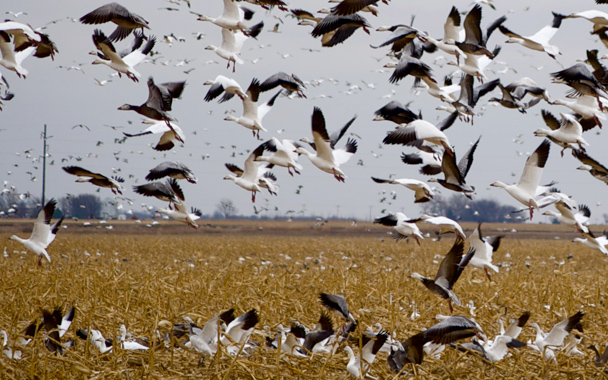It is almost over. You can feel it in the cold air: twelve degrees on Wednesday. Hard winter descended on South Dakota this week, froze the prairie potholes, and pulled a steel gray curtain over the sky. Farmers reached into the back of their closets and pulled out their insulated Carhartt overalls.
Jim Lutter’s harvest is finished. The buffalo are turned out for winter. The last forty-nine acres of Charlie Johnson’s organic corn will be in the bins by Friday. Soybeans are long gone. Oily black sunflower stems, chopped off two feet from the ground, stand at attention for mile after mile like an Andy Goldsworthy stick garden. Wildlife have taken possession of the barren fields, feeding on the “waste” and “litter” left by the harvest. Migrating snow geese gorge in the wheat stubble.
King Corn stands alone as the last crop, battered and wind swept. The gaudy tassel top hats of August have long since broken off and blown away. The plants seem to know. The pheasants know. The deer. The farmers. Just two more weeks, if the weather holds, maybe one.
Everywhere the corn is too wet. The elevators and ethanol plants have farmers over a barrel. They want contract corn to be under 18% moisture. They dock farmers whose deliveries are too wet. Sometimes they will dry the corn for farmers and charge a fee. But this year the harvest is so huge that no elevators have storage capacity. They are in a demanding mood.
The process of drying grain is part of the motivation behind the bin-building craze that has swept the Plains over the last decade. In the strange world of commodity economics it makes sense for farmers to build bins with huge propane dryers, and pass their crops from the field to the bins just long enough (a week or two) to get them below 18% moisture. Scott Christenson and his brother Roger are burning 1,500 gallons of propane every day to dry their corn…a mundane, barely recognized part of the carbon footprint of industrial farming.
Wednesday, November 19 Dale Hargens drops off a load of corn at the local ethanol plant in Redfield. The whole process takes ten minutes. At the exit he reaches out his window and tears off his receipt. The verdict: 995 bushels; 16.7% moisture. Solid. But he notices a sign. “As of November 20 no deliveries will be accepted over 16.5% moisture.” Dale grins. “Wow. Better hurry up and make another delivery before they close tonight.”
Scott Christenson spends all day in the combine, surrounded by computer screens that tell him how many bushels an acre he is processing, and how wet the corn is. The computer affirms his family philosophy. All farming is local, even within a field. The corn all looks the same, but the yield monitor fluctuates wildly from seventy-five or a hundred bushels an acre to two hundred as he drives along. The moisture is consistently over 20%. No break in store for the propane heaters.
Hours behind the wheel give Scott a lot of time to think. “I think the crunch for farmers from the Wall Street meltdown will come next year.” The first place Scott expects to feel the pinch is fertilizer. “Coops (dealers) bought expensive fertilizer last summer when oil prices were high. And they’ve been trying to get farmers to buy it. Some people did. We waited.” If input prices don’t come down, Scott says, he and his brother will plant soybeans next year instead of corn. “This year we knew everything was right to plant corn. We planted 80% of our ground in corn. And we’ve always believed that corn is king. But we don’t have any plans for next year. We’re going to wait and see. If input costs are too high, we’ll plant beans. They don’t need any fertilizer.”
I wait to hear any of our four farmers say they will take a week or two, to rest, now that the harvest is winding down. Maybe they will take their wives to dinner, watch a football game, go deer hunting. But none of them sees any rest in the near future. “I’ve got to clean out the stock yard,” says Charlie Johnson, as if he’s already late to the task. “We’ll let the manure dry out and then spread it on the fields. I’d like to get that done before the end of the year.” Dale Hargens is headed to a seed and fertilizer meeting at the local coop Friday night to plan next year’s planting. Scott Christenson says that after he has met all his contracts for this year he will still have 100,000 bushels of corn in storage on the farm. He plans to spend the winter “watching the market”. Corn prices have dropped to $3.40 a bushel, down from $7 a few months ago. If they go back up, he’ll sell. “Farmers can live on $3.70 corn.” He just hopes that prices don’t continue to drop below $3.
When all is said and done? When January gets so harsh that it pushes everyone indoors, what will our farmers do then? “Like everyone else,” Charlie laughs. “I’ll do my income taxes.”




 Pinterest
Pinterest


